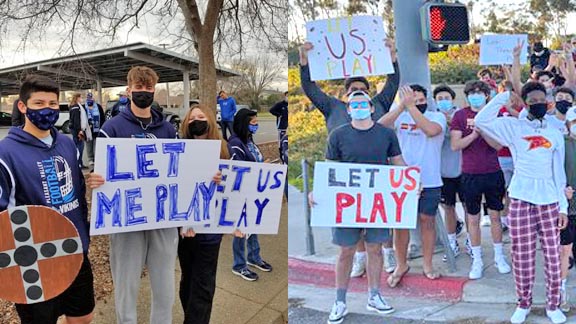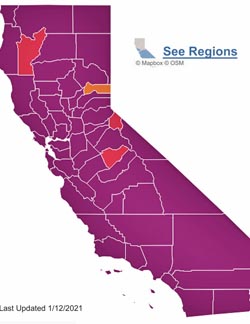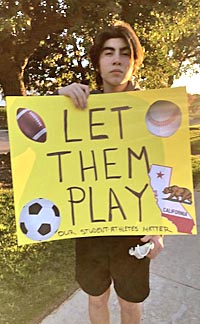
Student-athletes at Pleasant Valley of Chico (left) showed support for safe return to sports in their part of the state. At right are partners from Torrey Pines (San Diego). Photos: Twitter.com.
Thousands of people gathered at more than 130 different sites located just outside of school campuses throughout the state on Friday to advocate for a safe return to high school sports. It wasn’t promoted or presented as rallies specifically for football, but there was a decided prevalence of football players in jerseys at most of the rallies we checked out on social media. And for good reason. The time window for football to get played anywhere in the state during the 2020-21 school year is closing fast.
Note: We hope you enjoy this free post on CalHiSports.com. We’d love to get back to covering actual accomplishments by players, teams and coaches on the field, but the Coronavirus pandemic is perhaps at its worst point so far and it seems like the planned start of football is not going to happen for many weeks if at all. To check out getting a Gold Club membership to see all of our state record updates (five sports), totally authentic historical features, recruiting ratings and more, CLICK HERE.
The race is on. On one side there is the Coronavirus pandemic, which for the last month has been at its absolute worst in California in terms of positivity, cases, hospitalizations and death. On the other side is the number of days ticking off on the calendar to the point where entire seasons of high school sports will have to be canceled.
The big if, as usual, surrounds the spread of the virus itself. If the case numbers and ICU bed capacities in large swaths of the state don’t improve heading into the early weeks of February, it doesn’t look possible for any of the fall sports currently on the clock to be able to return. On the other hand, if those numbers improve and counties currently under stay-at-home orders get those orders lifted, then there’s a chance.

State’s most recent Covid19 map showed only four counties out of 54 that were not in the purple tier. The state also has reported an average of more than 500 deaths per day in the past week from the disease. Image: Covid19.ca.gov.
That’s where the type of support exhibited by the thousands of high school athletes, coaches, parents and others on Friday can make a difference. They can appeal to the many people who can sway public health opinion not to mention the various public health officials about returning to the field and courts earlier than is currently allowed.
All high school sports in California has been on pause since last March when the first outbreak of the pandemic not only impacted the California Interscholastic Federation’s state basketball championships (canceled on a Thursday morning before first games were to start the following day). Most spring sports teams (baseball, softball) only got in a few games and that was it for their seasons. Sports for the current 2020-21 school year scheduled to be played in the fall (football, girls volleyball, boys & girls cross country, etc.) were moved to a Season 1 that was supposed to be already underway in January.
Current California Department of Public Health guidelines don’t allow for any high school competitions until Jan. 25. Those guidelines were announced in early December and have not been updated. They don’t allow for anything when counties are under stay-at-home orders so that aspect of the pandemic will have to be overcome first before any return to play is feasible.
Several of the CIF sections have begun to show what their revised calendars may look like, shifting to reflect the CDPH charts that show which sports can be played in the purple tier or the one that shows the highest levels of spread for the disease. Those sports include cross country, boys and girls swimming, boys and girls tennis and boys and girls golf. Even though swimming, tennis and golf are traditionally played later in the school year, the thinking is that since those sports can be played in the purple then they can go first.
There are other sports listed in the current guidelines as being able to be completed in counties under the red tier, or second most severe levels of community spread. These include baseball and softball which wouldn’t be starting on the calendar as they look right now until late March. By that time, the hope among coaches and CIF officials is that there will be millions more in the state who’ve been vaccinated and that by then almost every county in the state will be in a much more secure position as it relates to schools reopening with in-person instruction and yes high school sports.
Football is currently shown in the orange tier, and given the challenges of the calendar, probably needs to be moved up into the red for it to have a chance of having any kind of a season. Most of those at the rallies on Friday weren’t looking at it in those precise terms, but that would seem to be a realistic goal and one that could make a difference at playing at all or not.

This student is shown from rally at Scripps Ranch High (San Diego). Photo: Twitter.com.
Many in the #LetThemPlay movement, which has more than 33,000 members in a Facebook Group as of Friday afternoon, point to other states that have had high school sports competitions already this school year. Almost all of those states, however, have elected Republican leaders who also have not done many other things during the pandemic (wearing face masks, etc.) that have been done in California (which obviously has elected Democratic leaders).
Another rapidly growing part of the effort to convince California leaders and public health officials to let kids play is the Golden State High School Football Coaches Community, started by Serra of San Mateo’s Patrick Walsh, who quickly got the backing and support of fellow De La Salle of Concord alum Justin Alumbaugh (now the head coach of the Spartans since 2013).
“No doubt, this is not about playing a game next week,” Alumbaugh said during a Saturday morning interview. “No one is advocating for playing when ICU beds are full. We just waited and waited for guidelines and then they came out in December and after that entire time we realized we should have played earlier. Many counties had already been in the orange tier.”
The better state example to follow may be Washington, which is also a very blue or Democrat state. In that state, a seven-week football season was approved last week going from Feb. 1 to March 20. Washington’s rates of community spread and other factors relating to the pandemic, however, are much lower than California’s. Still, a football season in California could potentially start by around March 1 and last until the middle of April. That doesn’t seem unreasonable at all and if the current surge in the state starts to come down would seem possible (if of course the sport can be moved into the red from the orange).
Alumbaugh added that Washington’s tier system is different than California’s. The California purple tier, for example, is for counties with a case rate of 7 per 100,000 population. In Washington, it is 28 per 100,000.
What We Saw On Friday
There were more than 130 places from north and south at which parents, coaches and student-athletes gathered. Everyone was asked to wear a mask and display social distancing (six feet apart). At most rally sites, there was more than one school represented, giving teams usually used to competing against each other the opportunity to come together for a cause they all believe in.
We couldn’t get to any of the actual rallies since none were close enough to our Stockton office and we have been abiding by stay-at-home orders in San Joaquin County. Our approach was to cover it the same as a Friday night during the football season, retweeting video highlights and coverage from our colleagues from all of the events we found on social media.
Among the rallies we ended up focusing on were several of them from San Diego County (which is where the #LetThemPlay group on Facebook is from and where the activism on the issue may be highest) plus two in Orange County, several in L.A. County, one near Centennial High (Corona) in Riverside County, one in Fresno, two in Contra Costa County, one in Tracy, one at Pleasant Valley of Chico, one held in Placer County, one in El Dorado County, and several more.
Other than from one photo from an event at Tehachapi (Kern County), we saw that it was almost 100 percent of those shown were wearing masks. The socially distance part of it wasn’t nearly as evident, but there were many events in which participants were spaced out on sidewalks, waving their signs as people drove by in cars. We saw only one event, at Oak Ridge of El Dorado Hills, in which people were sitting packed in and close to each other listening to speakers.
“It was all parent-driven at our school, but we supported them as much as we could,” Alumbaugh said. “We were hoping for positive momentum and looking to present the data that we have. The fear was that we’d see people not wearing masks and not following the rules, but we didn’t see any of that.”
The political reality in California is that the people that need to be reached through these rallies are Democrats and public health officials (since the Democrats will listen to them). There was only one event we saw in which there was a Republican politician speaking to the crowd (at Placer County) but there could have been more. Alumbaugh added that Walsh and himself have asked other coaches to avoid any hint of getting political on the issue.
The football coaches know that what happened Friday has to be more of a starting point for an even larger effort to sway public opinion. They know that there will be public health officials who may not agree with them and may have other data that should be looked at as closely as their own. They aren’t trying to be doctors, but they have been with their student-athletes the entire time of the pandemic and they are fighting to give them a season.
Mark Tennis is the co-founder and publisher of CalHiSports.com. He can be reached at markjtennis@gmail.com. Don’t forget to follow Mark on the Cal-Hi Sports Twitter handle: @CalHiSports




